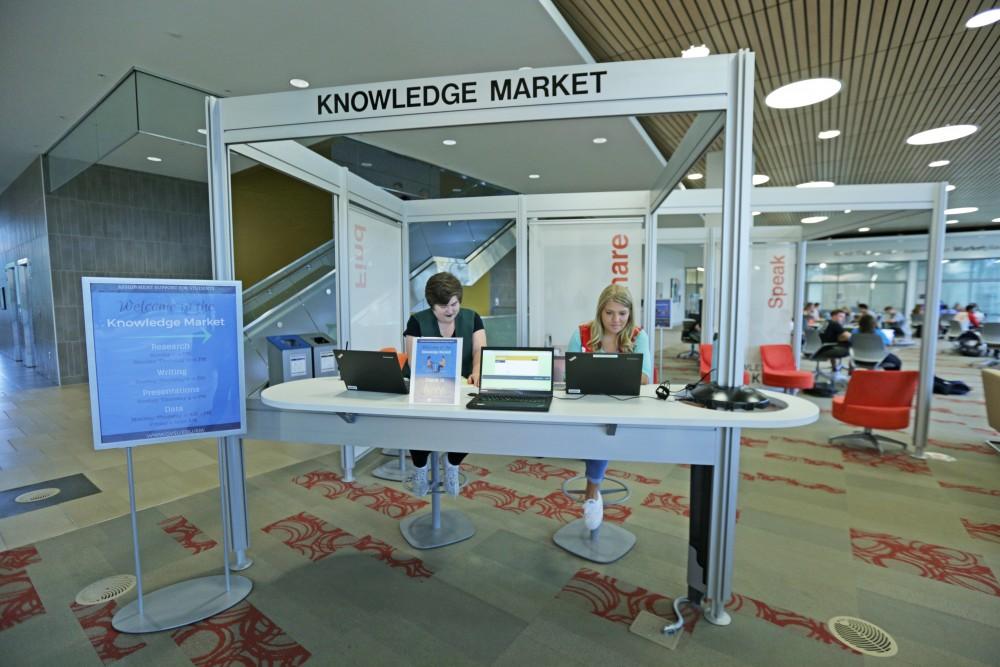‘Library Quest’ app set to guide students through library services

GVL / Emily Frye Ruth Ott and Natalie Loewengruber work at the Knowledge Market on Sunday September 17, 2017.
Sep 18, 2017
The Grand Valley State University libraries department has a multitude of services to offer for the enhancement of students’ academic experiences. Still, many students do not fully utilize these resources.
To address students’ lack of library service use, Kyle Felker, digital initiatives librarian at GVSU, set out on a “quest” to develop an app that would enable students to learn more about library resources and have fun while doing it.
A pilot for the “Library Quest” app was launched in 2012, after Felker and university libraries staff collaborated with an outside source, YetiCGI, to complete the coding.
“First, we were about to open a new $65 million library building, and we needed ways to take advantage of the upsurge of interest we knew this would create,” Felker wrote in a blog post following the app launch. “How could we get people curious about the building to learn more about our services and to strengthen that into a connection with us?”
Approximately 500 to 600 students used the app after its initial launch. After the first play period, it was time to reassess and make necessary improvements.
The app accomplished its goal of getting students more acquainted with library resources. However, many student users of the pilot happened to be in junior and senior standing, in which case, the demand for library services among then-users didn’t last long.
“I only just heard about Library Quest 2.0 this fall, but I wish I would have known about it earlier,” said Sabrina Williams, GVSU senior. “I feel like there are a lot of (library) services I could have benefited from had I known about them earlier.”
During the relaunched summer play period (Thursday, June 1, through Monday, July 31), only about 10 students used the Library Quest app. The fall play period started Friday, Sept. 1, and will continue through Tuesday, Oct. 31. This gives students ample time to download the app and become more acquainted with library services.
Felker said students tend to look for information they need at the library at the last minute, and not knowing enough about the resources can cause more stress than necessary.
“(The app) allows students to be more proactive,” Felker said.
The hope is that proactivity will relieve some unnecessary stress from the last-minute scramble.
Library Quest 2.0 is free for iOS or Android use. Features of the app include various “quests” student users can complete throughout the library. The app is GPS-oriented, so students must be in a GVSU library location to use it. After each quest, users gain a certain amount of points. Points earned are based on the difficulty and length of the quest.
The actual tasks can vary from physical quests, like checking into a study room, to digital quests.
“Students who play Library Quest become familiar with the many library resources, services and spaces that can support their learning,” said Kristin Meyer, user experience librarian at GVSU, via email. “I love that Library Quest helps students gain this knowledge in a fun and engaging way.”
Points earned from the quest can be converted into various prizes from the library front desk. Students have the opportunity to get notebooks, T-shirts, hats and more. Additionally, there is an overall prize at the end of the play period to win an iPad. Every 10 points a student earns equals one chance to win an iPad.
“The biggest challenge has been getting the word out and convincing students it’s worthwhile,” Felker said.
Before embarking on this task, Felker did not realize the extent of the costs for developing an app. In addition to the labor costs provided by YetiCGI, the app development was awarded a grant by the Institute of Museum and Library Services.
Whether or not the app will continue for another play period will be determined by the amount of student users and their feedback during the fall period.






















